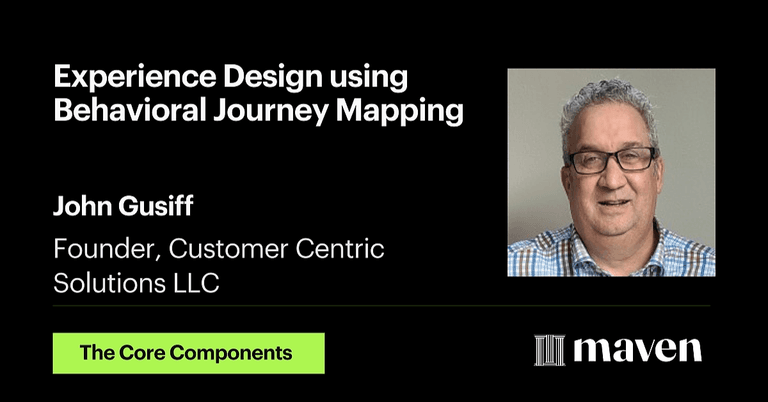How to utilize Top 3 Jobs-to-be-done (JTBD) Frameworks
This course reshapes how you understand customer behavior, decision-making, and innovation.
Rooted in Job Theory, you’ll shift from building around ideas and features to designing around customer progress—the true driver behind why people hire, switch, and stay with products. You’ll learn how struggles, context, and desired outcomes form real demand.
You’ll also contrast idea-driven innovation with JTBD-driven innovation, and see how JTBD aligns with the five types of innovation: product, service, operational, new market, and transformational.
Then you’ll get a clear side-by-side comparison of the top three JTBD frameworks:
Ulwick’s Outcome-Driven Innovation (ODI)
Kalbach’s JTBD Canvas 2.0
Boehme’s Wheel of Progress®
Each comes with unique strengths and blind spots. You’ll learn exactly when and why to use each, and how they complement one another across different innovation types, product decisions, and GTM needs.
In the final project, you’ll apply what you’ve learned by combining the right components from each framework to address your specific use case—giving you a practical, personalized approach you can bring directly back to your team.
What you’ll learn
By the end of this course, you’ll shift from a product-focused mindset to a customer progress and outcomes-oriented mindset.
Understand why customers “hire” products and what progress they’re truly trying to make.
Identify struggling moments, contexts, and desired outcomes that reveal real demand.
Use functional, emotional, and social jobs to uncover what drives customer choices.
See how context, constraints, and forces shape urgency, switching, and adoption.
Diagnose when teams are building around ideas rather than customer needs.
Reframe innovation around progress, outcomes, and causal mechanisms—not solutions.
Match product, service, operational, new-market, and transformational innovation to the right JTBD approach.
Choose frameworks based on innovation type, problem space, and organizational goals.
Ulwick’s Outcome-Driven Innovation (ODI): Learn how to quantify unmet needs using Opportunity Scores to prioritize your roadmap.
Kalbach’s JTBD Canvas 2.0: Map the customer’s end-to-end journey to uncover friction, tasks, and improvement opportunities.
Boehme’s Wheel of Progress®: Reveal the causal forces of switching behavior—pushes, pulls, anxieties, and habits.
Use the final project to blend the right elements from all three frameworks.
Leave with a personalized JTBD workflow you can immediately apply to product and GTM strategy.
Learn directly from JOHN

JOHN GUSIFF
John Gusiff is the Managing Partner for Customer Centric Solutions LLC.
Who this course is for
Product Strategists and Innovators looking to uncover and prioritize the progress customers are trying to make to guide product decisions.
Service Designers who want to map end-to-end experiences and identify friction that shapes how customers use and value a service.
CX & Customer Success who need to understand why customers “hire” or switch products to improve journeys, adoption, and business outcomes.
What's included

Live sessions
Learn directly from JOHN GUSIFF in a real-time, interactive format.
Lifetime access
Go back to course content and recordings whenever you need to.
Community of peers
Stay accountable and share insights with like-minded professionals.
Certificate of completion
Share your new skills with your employer or on LinkedIn.
Maven Guarantee
This course is backed by the Maven Guarantee. Students are eligible for a full refund up until the halfway point of the course.
Course syllabus
4 live sessions • 37 lessons • 6 projects
Week 1
Jan
12
Session 1: Introduction to Job Theory and JTBD Frameworks
Overview of Jobs to Be Done Theory
Overview of the Three Core Frameworks
Jan
14
Session 2: A Deep Dive into each Customer JTBD Framework (includes ChatGPT exercises)
Ulwick's Outcome-Driven Innovation (ODI)
Kalbach's JTBD Canvas 2.0
Boehme's Wheel of Progress® Framework (informed by Bob Moesta)
Recapping Key Strengths/Weaknesses of Each Framework
Jan
16
Session 3: Selecting the Right Framework for your Use Case
Establishing your JTBD Goals
Use Case Alignment with JTBD Framework
Week 2
Jan
21
Session 4: Group Shareouts of JTBD Use Case with Cohort
Shareouts and Group Discussion
Evaluating Resources and Constraints
Opportunities to Learn More
Free resource

Experience Design using Behavioral Journey Mapping
Introduction to the Make it Toolkit for Behavioral Design
Making the Design Sprint process more human-centered by integrating the makeit toolkit into it.
Overview of the Five Laws of Behavior
The Five Laws of Behavior B=f(P,E), B=f(S1,S2), A->B->C, B=MAP, and B=f(I,E) to inform behavioral design.
Behavioral Journey Map vs. Traditional Journey Map
The core differences between a behavioral journey map and a traditional journey map (focus, design objective, etc.).
Core Components of a Behavioral Journey Map
The core components to a behavioral journey map (prompts, behavior, consequences, barriers, and opportunity points).
Schedule
Live sessions
8 hrs
Four LIVE cohort sessions; interactive exercises built around B2C and B2C case studies; all sessions recorded.
Mon, Jan 12
6:00 PM—8:00 PM (UTC)
Wed, Jan 14
6:00 PM—8:00 PM (UTC)
Fri, Jan 16
6:00 PM—8:00 PM (UTC)
Wed, Jan 21
6:00 PM—8:00 PM (UTC)
Projects
3 hrs
Final student project (choose your own case study) to apply the different frameworks as a workflow using different components from each to accomplish the key objectives (outcomes).
Async content
3 hrs
Articles and videos to provide additional background on job theory and the different jobs-to-be-done frameworks.
Testimonials
- John is a great course instructor. Not only are his presentations high quality, he also gives illustrative B2C & B2B examples from his rich consulting experience.

Pete Savigny
Senior UX Researcher - As a CX practioner, I was seeking deeper knowledge of the Jobs to be Done methodology to better understand customer needs. This training delivered - providing a comprehensive overview of JTBD frameworks and methods, plus invaluable hands-on practice (leveraging ChatGPT).

Michael Mattson
Experience Management, Travelers - The extensive material John provides about the JTBD framework, and how easy he makes it look, clearly show his experience. The addition of ChatGPT to test different scenarios offers an interesting approach to how GenAI can help inform human-centered design.

Jose Diaz
UX Lead Designer, Ludicrum - Terrific course for Product Marketers looking to conduct deeper customer research. John teaches how to get the crowd knowledge quickly using ChatGPT and then dive into different synthetic personas.

Josh Porter
Product Marketing Director - John's course cover both the principles and methods along with practical exercises to quickly apply what you've learned. More interactive, rather than just a lecture. Much better for being able to use JTBD in my work world.

Carla Fleming
B2B Product Marketing, Pivoting Strategies LLC - The Forces and Desires Model of itself is like 'gold'. It helped us build a better understanding of homeowner motivations and switching behavior related to moving in, repairing, upgrading, maintaining or improving their homes.

Kyle Sandburg
Former VP Strategy, Porch.com
Frequently asked questions
$675
USD
